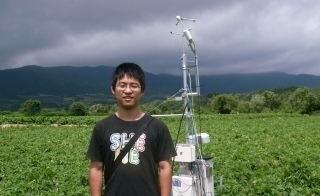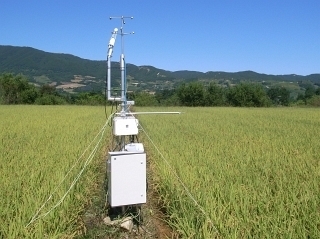Spatial assessment of atmosphereecosystem exchanges via micrometeorological measurements, footprint modelling and mesoscale simulations
TERRECO WP 1-02
Von 03/2009 bis 08/2014Projektleiter: Johannes Lüers, Thomas Foken, John Tenhunen
Mitarbeiter: Peng Zhao
Bewilligung: IRTG 1565 WP I TERRECO - Complex Terrain and Ecological Heterogeneity - Evaluating ecosystem services in production versus water yield and water quality in mountainous landscapes
Abstract 2011: Our research project is focused on the energy and net ecosystem exchange of agro-ecosystems over a complex mountainous landscape in South Korea. Eddy-covariance technique was used at a flooded and a dry crop field during the growing season in 2010. The footprint model shows that the target farmlands generally contributed most of the relevant area to the turbulent flux measurements. The turbulent energy exchange was controlled by the cover of leaves on the surface. Net ecosystem CO2 exchange (NEE) was controlled predominantly by solar radiation with respect to diurnal patterns and predominantly by the growing stage of the crop with respect to the seasonal pattern. A late-season depression of NEE was observed at the potato field caused by the postponed harvest, which turned the field into a small source of carbon dioxide. An innovative gap filling method on the basis of Michaelis-Menten function was raised for rapidly developed crop sites without long term measurements, and showed a better regression than the traditional method. A comparison between eddy-covariance and chamber measurements showed poor agreement, which needs further study. WRF model was evaluated using quality controlled eddy-covariance measured fluxes. The simulated data had a better agreement with the observed data for both sensible and latent heat flux at the rice field than at the potato field. The underestimation of sensible heat flux and overestimation of latent heat flux at the potato field is similar to the WRF performance at a mountainous forest site in Germany.
Keywords: eddy-covariance; net ecosystem exchange; gap filling; complex terrain; WRF model; chamber measurement
project description in detail from proceedings of 2011 TERRECO Science Conference GAP


Abstract 2013: Agricultural areas comprise nearly 40% of the land surface of the earth. In order to meet the demands of the increasing human population and growing economies, the intensification of crop cultivation has led to rapid land use and land cover change. In the context of global change, major efforts are being made to understand the role of cropland ecosystems in atmosphere/biosphere CO2 exchange, in potential carbon sequestering versus release, and to relate CO2 exchange to future agricultural production and yields. The objective of this study is to better understand the CO2 exchange between cropland ecosystems and the atmosphere under monsoon climate conditions in Korea by assessing the dynamics of the CO2 exchange during entire growing seasons for major crops. Field campaigns were carried out in an irrigated rice field and a non-irrigated potato field in Haean Catchment, South Korea during the growing seasons in 2010 and 2011. Eddy-covariance technique was used to observe net ecosystem CO2 exchange (NEE). Meteorological variables and biomass change of both crops were additionally measured. State-of-the-art quality control approaches were applied to confirm the reliability of the data-sets. Conventional and new gap-filling methods together with partitioning methods were used to provide continuous time series of NEE and gross primary production (GPP) of the croplands. We found that the primary causal factors for seasonal changes in GPP were related to the changes in Leaf Area Index (LAI) for both crops. The diurnal change in GPP is driven primarily by solar radiation. The photosynthetic efficiency of rice under cloudy conditions (leading to predominance of diffuse radiation) is 20% greater than under clear sky conditions (with direct radiation). The photosynthetic efficiency of potatoes showed no difference between sunny and cloudy days. The seasonal change in ecosystem respiration at the reference temperature in the rice field follows the change in rate of LAI. Vapor pressure deficit (VPD) plays a significant role in the dry, pre-monsoon growing stage of non-irrigated crops, and a minor role under Asian monsoon weather conditions.
Key words: net ecosystem exchange, eddy-covariance, croplands
Poster Workshop Ecosystem Change and Society, Bayreuth, January 2013
